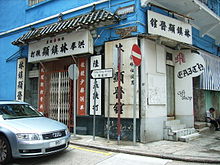Blue House (Hong Kong)
| Blue House | |
|---|---|
藍屋 | |
 Blue House in 2018 | |
| General information | |
| Architectural style | Tong lau |
| Classification | Grade I historic building |
| Location | Wan Chai |
| Address | 72-74A Stone Nullah Lane |
| Country | Hong Kong |
| Coordinates | 22°16′26″N 114°10′27″E / 22.273897°N 114.174146°E |
| Named for | Blue outer walls |
| Construction started | 1920 |
| Completed | 1922 |
| Technical details | |
| Floor count | 4 |
| Blue House | |||||||||||||
|---|---|---|---|---|---|---|---|---|---|---|---|---|---|
| Traditional Chinese | 藍屋 | ||||||||||||
| Simplified Chinese | 蓝屋 | ||||||||||||
| |||||||||||||
Blue House refers to a 4-storey balcony-type tenement block located at 72-74A Stone Nullah Lane, Wan Chai, Hong Kong. It is named after the blue colour painted on its external walls. It is one of the few remaining examples of tong lau of the balcony type in Hong Kong and is listed as Grade I historic building.[1]
Historic background
The building was the original site of the first hospital 'Wah To Hospital' (aka "Wan Chai Kai Fong Hospital"), which was built in the 1870s in Wan Chai.[2] The hospital, which provided Chinese medical services to local Chinese, was possibly the first hospital in the district.[3]
After the hospital closed in 1886, the two-storey building was then used as a temple for Wah To, the revered Chinese physician from the Three Kingdoms period.

The building was demolished in 1920 and was built into four four-storey tenement blocks in 1922. After the Japanese occupation of Hong Kong in 1945. The building was subsequently used as a martial arts school and Dit Da clinic by Lam Cho, the adopted nephew of Lam Sai-wing.[3]
The building was acquired by the government in the 1970s, and in 1990 the outer walls were painted blue, thus earning it the name Blue House.[4]
Future revitalisation
All the upper floors of Blue House, apart from 72 Stone Nullah Lane, are timber structures. The two wooden stairs, with original elements intact, are well maintained.[3]
The building was part of a HK$100 million plan, unveiled by the Housing Society and the Urban Renewal Authority, to preserve nine Chinese-style buildings in Wan Chai that were constructed during the 1920s.[4]

The building has been preserved and revitalised in a traditional tea and medicine style.[5]
In 2007, the Urban Renewal Authority and the Development Bureau jointly announced that the residents of the Blue House, were to be allowed to stay in this historic monument.[6] On the same year, one of the ground floor's shophouses of the building was occupied as a location of the Wan Chai Livelihood Place, which was later renamed as the Hong Kong House of Stories in March 2012. The building closed for renovation in 2015.
The building was fully renovated and opened in 2016. It won the 2017/2018 architectural prize in 2018.[7]

See also
- Green House (Hong Kong)
- Revitalising Historic Buildings Through Partnership Scheme
- Wan Chai Heritage Trail
References
- ^ List of the 1,444 Historic Buildings in Building Assessment (as of 23 October 2015)
- ^ "HKHS:Revitalization / Preservation Project in Wan Chai". Archived from the original on 30 October 2006. Retrieved 15 December 2006.
- ^ a b c Revitalization / Preservation - Hong Kong Housing Society Archived 9 December 2006 at the Wayback Machine
- ^ a b Michael Ng, plan to revisit area's colorful history Archived 22 May 2014 at the Wayback Machine, The Standard, April 1, 2006
- ^ Wan Chai landmark to be immortalised
- ^ Wan Chai facelift to save historic market, The Standard, 21 December 2007
- ^ "活化不失原有建築物風格 We嘩藍屋奪獎". on.cc東網 (in Chinese (Hong Kong)). Retrieved 5 April 2019.

